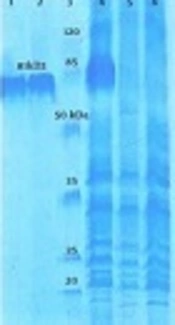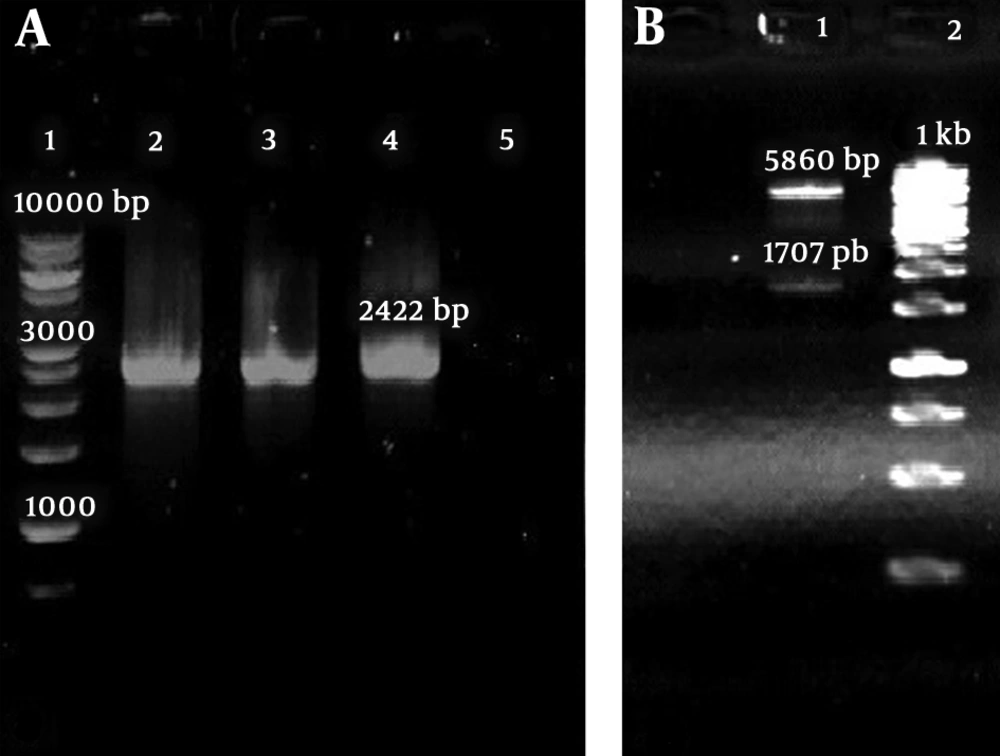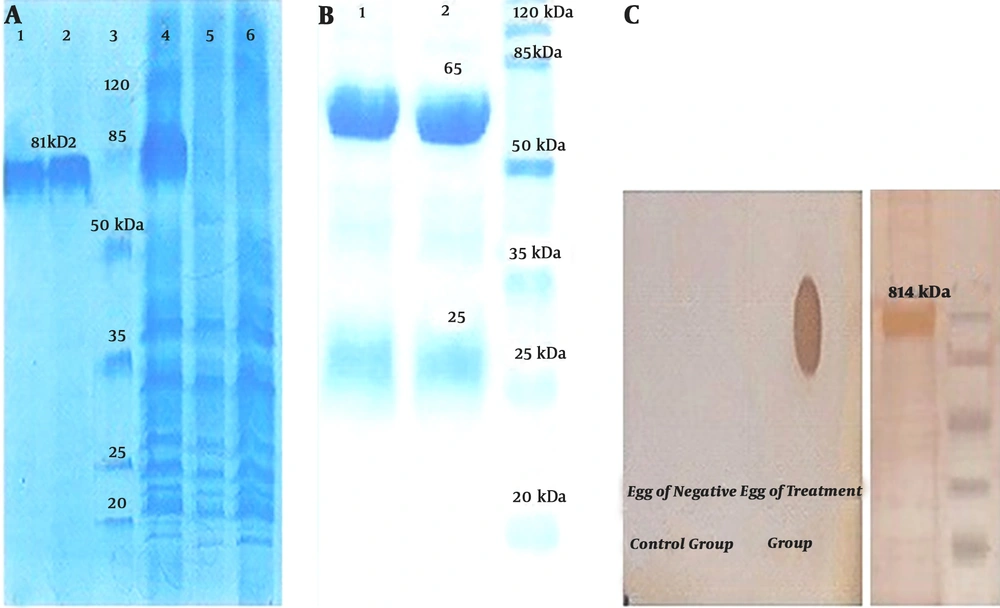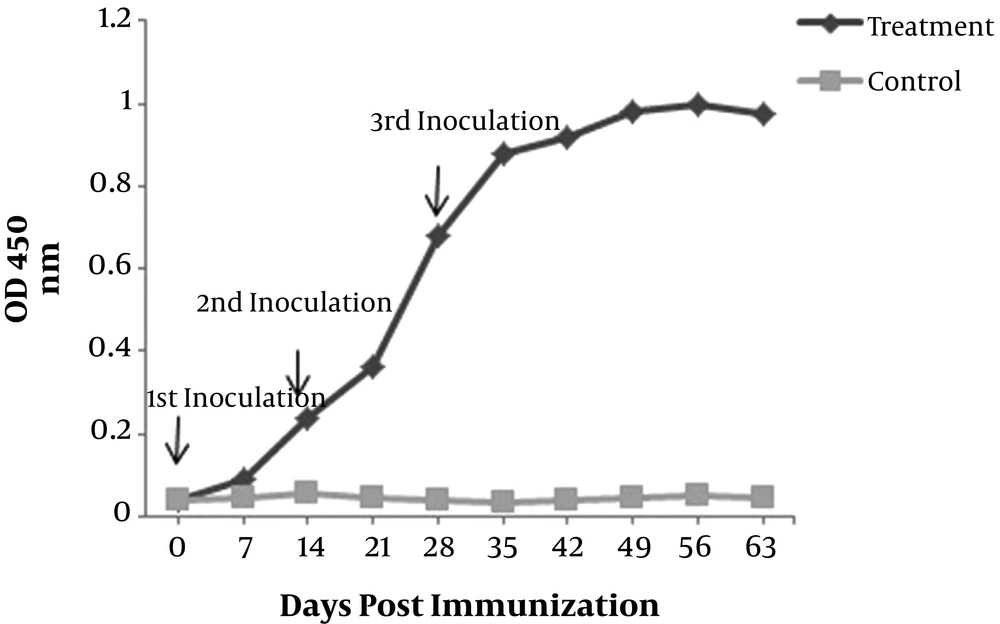1. Background
Salmonella enterica are important gram-negative bacteria that are responsible for food-borne disease gastroenteritis and comprises of about 2500 serovars (1). Salmonella can infect warm-blooded animals and humans. Salmonella typhimurium is related to the consumption of contaminated poultry meat and eggs (2). The major pathogenicity islands of Salmonella include SPI1, SPI2, SPI3, SPI3, SPI4, and SPI5. SPI1 and SPI2 are the most important virulence factors of Salmonella enterica that code type III secretion systems (T3SS-1). The type III secretion system plays an important role in infusion of effector proteins in the cytosol of eukaryotic cells (3). Various parts of the type III secretion system are organized in a supramolecular frame, known as the needle complex (4). It has been reported that SPI1 virulence factor plays a role in the intestine for initiation of inflammatory responses and the invasion of the intestinal epithelium cells (5). Also, the SPI2 virulence factor leads to improvement in Salmonella survival within macrophages and multiplication in phagocytic cells (3). The major genes of SPI1 include invA, invB, invC, invE, invF, invG, invH, hilA, sipA, sipC, sipD, spaR, orgA, sipB, and sptP. The InvG gene located on SPI1 encodes an essential component of the base substructure of the needle complex (4). The InvG gene is one of the primary genes located in the membrane of bacteria and plays a major role in the initial binding of the bacteria to the host cells. There is evidence that InvF and InvG genes of SPI1 are essential for effective entry of Salmonella to epithelial cells (6). As a result, the invG protein can be suitable as a recombinant protein to stimulate the immune system against Salmonella typhimurium.
In the recent years, there has been an increasing prevalence of antibiotic-resistant bacteria, which has led traditional antibiotics to become less effective. Oral administration of specific antibodies is an excellent source to protect humans and animals against gastrointestinal pathogens (7). An egg yolk antibody called IgY has been used widely for protection and treatment against infections (8). Several researches have proven that use of IgY is effective as passive protection against infections, such as Enterotoxigenic Escherichia coli, bovine coronavirus, bovine rotavirus, Salmonella, Pseudomonas, and Staphylococcus (9, 10). It was reported that IgY (egg yolk immunoglobulin) from immunized chickens is safe, protective, and effective against intestinal infection in human and animals (11).
2. Objectives
The current research attempted to produce anti-InvG IgY by immunizing hens with recombinant InvG antigen and investigate the specificity of anti-InvG IgY of Salmonella typhimurium.
3. Methods
3.1. InvG Gene Amplification
Genomic DNA was extracted from a standard strain of Salmonella typhimurium (ATCC = 14028) (Bioneer, Korea). Oligonucleotide primers containing BamHI and XhoI restriction sites (underlined) were designed using primer 5 software and then primers were synthesized by Macrogen (South Korea). The primer sequences were InvG-Forward:
5'-CGCGGATCCGCGGGCAGACAAATGAAGACACATA-3' and InvG-Reverse:
5'-CCGCTCGAGCGGTTTAATTGCCTCCTGACCTCTAT-3'. Polymerase Chain Reaction was performed in a 25-µL volume containing 1.5 μL of MgCl2 (50 mM), 2.5 μL of 10X PCR buffer, 2 μL of each deoxynucleoside triphosphates, (20 mM), 2 μl of mix primer (10 pmol/μL), 2 μL of DNA template (50 ng/μL), and 1.25 U of Pfu DNA polymerase and some deionized water. The conditions for InvG gene amplification included denaturation at 94°C for six minutes, followed by 32 cycles of denaturation at 94°C for 30 seconds, annealing at 58°C for 30 seconds and extension at 72°C for 45 seconds, and final extension at 72°C for 10 minutes.
Ligation reaction of InvG gene in the pTZ57R/T plasmid (Fermentas, Germany) was performed by the T-A clone. The ligation product was transformed in E. coli DH5α. Then, transformed cells were selected and the positive bacterial clones were confirmed by restriction enzyme digestion and PCR colony using InvG primers.
3.2. Expression of the Recombinant InvG Protein
The plasmids pTZ57R/T-InvG and pET32a were digested using BamHI and XhoI enzymes and purified by the gel DNA recovery kit. The T4 DNA ligase method was used to ligate InvG gene in the pET32a vector (16 hours at 16°C). The recombinant pET32a-InvG vector was transformed to E. coli (TOP10F' cell). The transformed cells were grown overnight at 37°C on LB agar plates with ampicillin (100 μg/mL). The recombinant pET32a-InvG colonies were analyzed by enzyme digestion (BamHI and XhoI) of the recombinant plasmid and the PCR colony method. The PCR colony was performed with specific oligonucleotides of the InvG gene and pET T7 primers. The recombinant pET32a-InvG vector was sequenced to confirm the integrity open reading frame of the recombinant plasmid.
For expression, the recombinant plasmid was transferred to E. coli BL21 (DE3) inoculated in Luria broth culture containing ampicillin with a concentration of 100 μg/mL and grown overnight at 37°C in 150 rpm. Overall, 50 mL of fresh LB liquid containing ampicillin (100 μg/mL) was incubated with 5 mL of pre-culture at 37°C in 150 rpm to reach OD600:0.6. Then, the InvG protein was induced by 1.5 mM IPTG and incubated at 37°C for four hours with shaking at 150 rpm. After induction, samplers of the recombinant protein were harvested at different time points. The InvG expression was subjected to 12% SDS-PAGE.
3.3. Dot-Blotting and Western-Blotting Analysis
Overall, 2 μg/mL of 6X his-tagged recombinant InvG protein, PBS as a negative control, and the extract of the transformed bacteria were dotted on the nitrocellulose membrane. It was immersed in 1% bovine serum albumin and shaken (30 minutes). In the next step, it was washed with PBST. The membrane was immersed in anti-His-tag rabbit diluted at 1:500 (one hour). Next, the membrane was washed with PBST and incubated with anti-rabbit IgG (H+L) and HRP conjugate (one hour). The membrane was washed with PBST. Color development was detected by addition of 3, 3’-diaminobenzidine dissolved in PBS and H2O2.
For Western-blotting, the recombinant InvG protein was separated using 12% SDS-PAGE and transferred on the nitrocellulose membrane. The BSA 1.5% (w/v) was used to block sites and incubated at 4°C overnight. The membrane was incubated with primary antibody (1:1000). Anti-rabbit IgG conjugated to HRP was applied as the secondary antibody (1:2000). The membrane was placed in peroxidase chromogenic substrate solution (3, 3-diaminobenzidine, Sigma), and dissolved in H2O2 to stop the color development.
3.4. Purification of the Recombinant InvG Protein
The recombinant InvG protein was purified using Qiagen nickel-nitrilotriacetic acid agarose column (Qiagen, Hilden, Germany). The pellet of the induced cells was re-suspended in lysis buffer (10). Overall, 1 mg/mL of lysozyme was added to the pellet. Then, it was incubated on ice (30 minutes) and disrupted by sonication. In total, 1 mL of the 50% Ni-NTA slurry to 10 mL cleared lysate was shaken at 4°C for 60 minutes. The lysate-Ni-NTA mixture was loaded on a column. The recombinant protein was washed. The 6X his-tagged recombinant protein was eluted with elution buffer (10). The InvG protein concentration was determined using the Bradford method (12). Before the hen immunization with the InvG protein, it was dialyzed to remove imidazole and other impurities.
3.5. Immunization of Hens
In the initial immunization, the laying hens were inoculated with 200 µg of the recombinant InvG protein+200 µL of complete Freund’s adjuvant (Sigma, USA) through intramuscularly injection. The second and third immunization were followed with a two-week interval and the hens were injected with 200 µg of the recombinant InvG + 200 µL of incomplete Freund’s adjuvant. In the control group, the hens were injected with Freund’s complete adjuvant only. Laid eggs were collected daily after the first immunization for ten weeks, and marked and stored at 4°C.
3.6. IgY Antibody Purification
The IgY antibody was purified using polyethylene glycol precipitation procedure (13). The purified IgY was investigated on sodium dodecyl sulphate polyacrylamide gel electrophoresis.
3.7. Dot-Blotting and Western-Blotting of Anti-InvG IgY
Dot-blotting and Western-blotting analyses were carried out as described previously (10), only with the difference that the primary antibody was hen anti-InvG IgY.
3.8. Indirect Enzyme-Linked Immune Sorbent Assay
Activity of IgY against the InvG protein was specified by iELISA. Overall, 2 µg/mL of the InvG protein diluted in PBS was coated on wells overnight at 4°C. After three times washing (PBS-Tween), plates were blocked with 1% BSA (at 37°C for 1 hour). Subsequently, 100 µL/well of IgY diluted in PBS (1:2000) was added and incubated with 100 µL/well of rabbit anti-chicken IgY H&L (HRP) and diluted in PBS (1:10000) for two hours at 37°C. The colorimetric detection was performed using O-phenylenediamine (Sigma) and the plate was washed with PBST. The reaction was stopped by the addition 3 M H2SO4 to the wells. The absorbance was measured at 492 nm.
3.9. Statistical Analysis
Statistical analysis was performed using the SPSS 19.0 statistical package (SPSS, Chicago, IL, USA). Differences in mean ELISA titers between weeks were estimated by comparing the means using repeated measures analysis of variance (ANOVA). A P value of less than of 0.05 was considered significant.
4. Results
4.1. Amplification of InvG Gene and Cloning of the InvG Gene
The coding region of the InvG gene was amplified by PCR (Figure 1A). The purified InvG gene was successfully inserted in the t pTZ57R/T vector to construct the recombinant pTZ57R/T-InvG plasmid. The results of PCR assay with specific primers and restriction enzyme revealed that the InvG gene was correctly inserted in the pTZ57R/T vector (Figure 1B). Also, colonies of the recombinant pET32a-InvG vector were corroborated with PCR using pET T7 primers (Figure 2A). The existence of the InvG gene in the pET32a vector was corroborated by enzymatic digestion (Figure 2B).
4.2. Expression and Purification of the Recombinant InvG Protein
The results of the InvG expression at different time points were indicated on 12% SDS-PAGE electrophoresis by induction with 1.5 mM IPTG (Figure 3A). Figure 3 shows that the InvG gene was expressed in E. coli. The recombinant InvG protein could be identified around 81 kDa (pET32 (18.5 kDa) + InvG (62.275 kDa). The result of Western-blotting and Dot-blot analysis verified existence of the recombinant InvG protein (Figure 3B and C). The recombinant InvG protein was purified using Ni-NTA agarose column (Figure 4A). The concentration of InvG protein was calculated as 1.52 mg/mL.
A, the results of SDS-PAGE. Lane 1: non-induced cells, lane 2 to 5: cells induced with IPTG at one, two, three, and four hours after induction, respectively, lane 6: protein size marker. B, Western-blot analysis of the InvG protein. C, Dot-blot analysis of the InvG protein [(A) PBS, (B) E. coli-pET32a-InvG and (C) E. coli-pET32a-InvG shows transformed bacteria induced with IPTG].
A, purification steps of InvG protein was electrophoresed on 12% SDS-PAGE. Lane 1 1 to 2: the purified InvG protein, lane 3: protein size marker, lane 4 to 5: cleared cell lysate, lane 6: flow-though. B, SDS-PAGE analysis of the purified IgY antibody. C, Dot-blot and Western-blot of anti-InvG IgY.
4.3. Analysis of IgY- InvG
The IgY antibody was extracted from the egg yolks by PEG precipitation method. The result of IgY was electrophoresed on 12% SDS-PAGE and indicated that IgY contains two main proteins with a light chain (25 kDa) and heavy chain (65 kDa) (Figure 4B).
4.4. Dot Blotting and Western Blotting Analyses
The results revealed that anti-InvG IgY in 1:2000 dilution could detect the recombinant InvG protein. Western blot analysis detected an 81 kDa protein band (Figure 4C).
4.5. Specific Activity of IgY
The anti-InvG IgY activity was determined by iELISA. Mean ELISA titers of the anti-InvG IgY in two groups of laying hens are shown in Figure 5. There was a significant increase of the specific Anti-InvG IgY activity after the second week and the results showed specific antibody activity was gradually increased (P value < 0.05). Significant differences were seen after the first immunization between the different weeks (P value < 0.05). After the second and third injection, the anti-InvG IgY level was increased. As a result, significant differences were showed between the fourth and sixth weeks with the other weeks (P value < 0.05). Subsequently, the antibody levels reached the peak in 56 days after the first immunization. Also, significant differences were shown in the specific IgY activity between the third, fifth, and seventh week compared with other weeks (P < 0.05). However, there was no significant difference between sixth and seventh weeks. No significant difference was revealed in the IgY activity in the last weeks of egg collection, indicating that the IgY level remained constant. In the control group, considerable change was not found.
5. Discussion
Salmonella disease has been identified as one of the main foodborne infections in humans and animals (14). It is essential to prevent Salmonella infection, not only to decrease productive losses in farm animals, but also to control its transmission to humans. Therefore, determining suitable methods of Salmonella surveillance will greatly assist the industry in recognition and control of Salmonella infections. In the recent years, there have been some researches of the resistance to commonly used antibiotics in different pathogens. As a result, serious concerns have arisen about the potential risk to human health from drug residues and the possible transfer of antibiotic resistant genes from animal to human microbiota (15). Passive immunization is an excellent method for control and therapy of Salmonella enterica infections. Antibody Y is one of the candidates for oral administration approach. Use of IgY has advantages, such as high yield, convenience, and cost-effectiveness (11).
Several researches have indicated that specific IgY is greatly effective against Salmonella. Lee et al. (16) revealed that specific IgY against Salmonella was able to prevent Salmonella growth. Also Salmonella-specific IgY was able to bind to the antigens expressed on the Salmonella surface, causing structural alterations in the bacterial surface. Gurtler et al. (17) evaluated the impact of oral administration of IgY on Salmonella contamination rate of eggs laid in hens. They suggested that IgY as a feed additive could be used to decrease the Salmonella contamination rate of hen’s eggs. Chalghoumi et al. (18) immunized hens with outer membrane proteins of Salmonella enteritidis and Salmonella typhimurium. They produced specific IgY simultaneously against enteritidis and typhimurium in the same egg yolk. Gorbani et al. (19) produced specific IgY against Salmonella using Salmonella typhimurium-heat-killed whole cells and their results indicated that the egg yolks from hens immunized with Salmonella typhimurium protected mice from Salmonella. Li et al. (20) revealed that IgY modulated intestinal mucosal immune responses during Salmonella typhimurium infection.
The main strategy in this study was to clone and sub-clone InvG antigen of Salmonella typhimurium in expression plasmid and express this in E. coli. The pET32 as a recombinant vector was used in this study. The pET32 series is designed for cloning and high-level expression of peptide sequences fused with the 109aa Trx•Tag™ thioredoxin protein. Cloning sites available for producing fusion proteins also contain cleavable His•Tag® and S•Tag™ sequences for detection and purification of recombinant proteins (21). The InvG protein was inoculated to the laying hens to produce anti-InvG IgY. Anti-InvG IgY was detected in egg yolk of immunized hens. The findings of this research were in accordance with the findings of other researches that suggested hen immunization is a promising method for the production of antibodies (22, 23). In this study, anti-InvG IgY was produced by immunizing the chicken with the InvG protein, which has never been reported before, according to the current study. The InvG antigen amount showed that it stimulated the immunological response. The results showed the InvG antigen could be identified specifically by anti-InvG IgY. The anti-InvG IgY was detected after the second week of post-injection in yolks. Fu et al. (24) explained that it takes two weeks for the production, transformation, and accumulation of specific IgY in the egg yolk. In the current study, antibody titer started to increase after the second week and reached the peak in 56 days after the first immunization.
These results were in agreement with the findings of the other researches that corroborated that E. coli expression system was able to express InvG protein of Salmonella (25, 26). Also, the results were in accordance with other results that showed specific anti-Salmonella IgY was produced using immunizing hens with Salmonella (18, 19).
5.1. Conclusions
The findings of the present research indicated that anti-InvG IgY could be utilized as one of the methods for immunotherapy to identify Salmonella infection. The anti-InvG IgY could be applied in specific diagnostic method of Salmonella infection. Further experiments are recommended with different titers of IgY in order to evaluate the preventive effect of anti-InvG against Salmonella infection.



![A, the results of SDS-PAGE. Lane 1: non-induced cells, lane 2 to 5: cells induced with IPTG at one, two, three, and four hours after induction, respectively, lane 6: protein size marker. B, Western-blot analysis of the InvG protein. C, Dot-blot analysis of the InvG protein [(A) PBS, (B) <i>E. coli</i>-pET32a-InvG and (C) <i>E. coli</i>-pET32a-InvG shows transformed bacteria induced with IPTG]. A, the results of SDS-PAGE. Lane 1: non-induced cells, lane 2 to 5: cells induced with IPTG at one, two, three, and four hours after induction, respectively, lane 6: protein size marker. B, Western-blot analysis of the InvG protein. C, Dot-blot analysis of the InvG protein [(A) PBS, (B) <i>E. coli</i>-pET32a-InvG and (C) <i>E. coli</i>-pET32a-InvG shows transformed bacteria induced with IPTG].](https://services.brieflands.com/cdn/serve/3170b/7f864c11a6f7140b1f74914609dc253d372a8b07/iji-87683-g003-F3-preview.webp)

